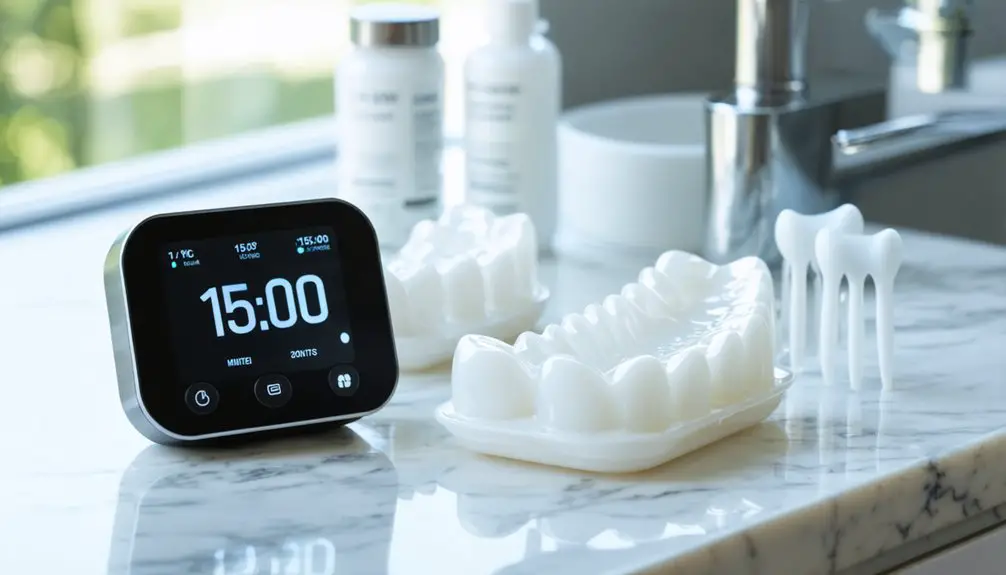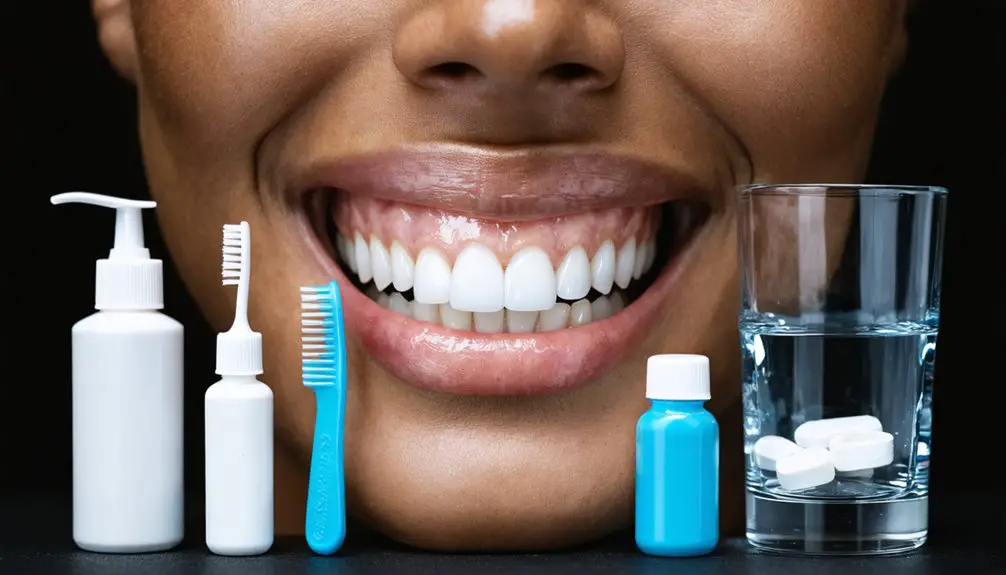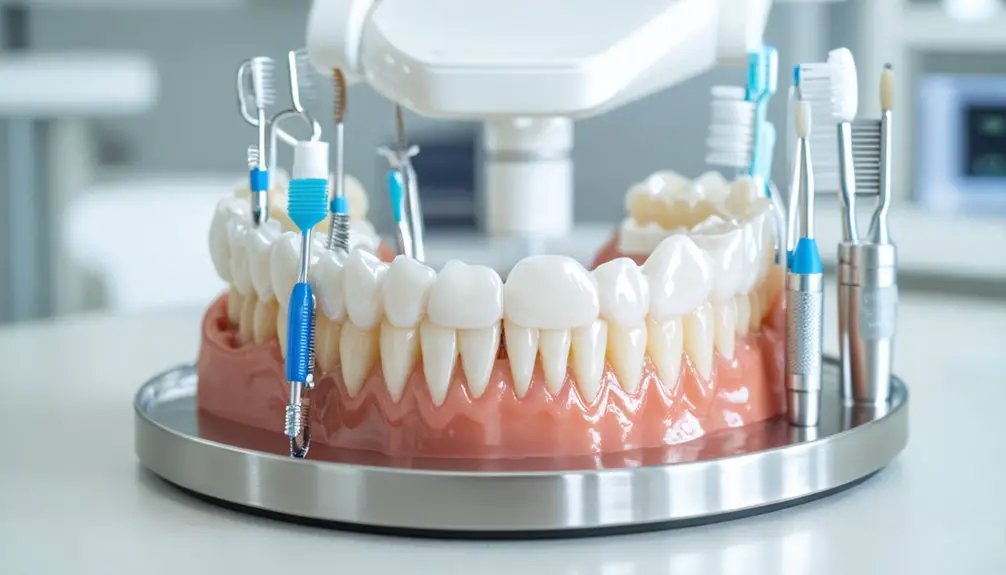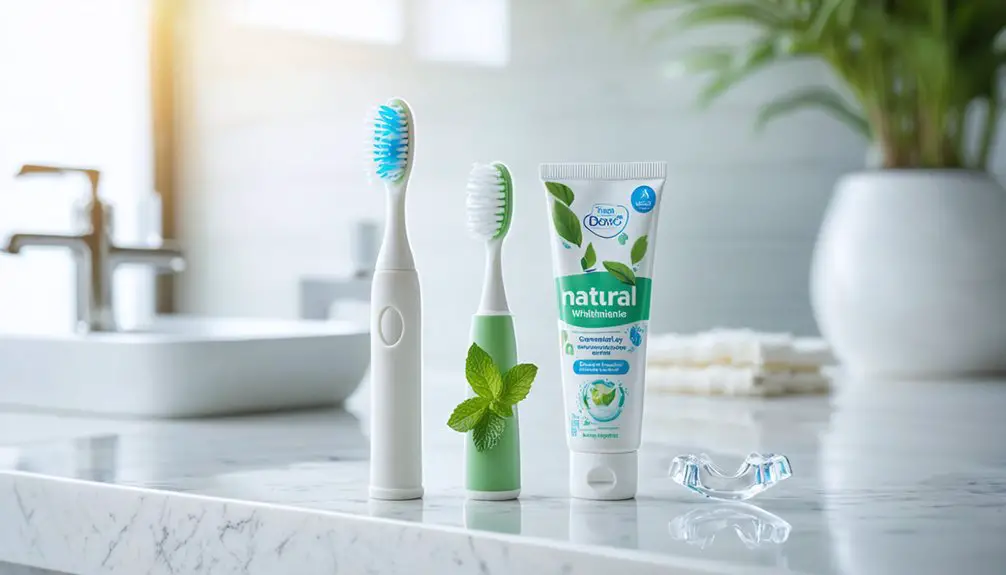You can prevent teeth whitening sensitivity by starting with desensitizing toothpaste weeks before treatment, opting for professional whitening over DIY methods, and strengthening your enamel with fluoride treatments. It’s crucial to modify your diet during the process, master gentle brushing techniques, properly time your whitening sessions, and use post-treatment sensitivity relief products. Understanding these proven preventive strategies will help you achieve a brighter smile with minimal discomfort.
Key Takeaways
- Use desensitizing toothpaste containing potassium nitrate at least two weeks before and during whitening treatment to reduce nerve sensitivity.
- Get professional fluoride treatments or use fluoride rinses before whitening to strengthen enamel and create protective barriers.
- Choose gentle whitening methods with lower peroxide concentrations under professional guidance to minimize sensitivity risks.
- Avoid extremely hot, cold, or acidic foods during whitening treatment and stick to neutral temperature, non-pigmented foods.
- Practice gentle brushing techniques with soft-bristled toothbrushes and wait 30 minutes after whitening before brushing teeth.
Start With Desensitizing Toothpaste Weeks Before Treatment
While teeth whitening can effectively brighten your smile, it often causes temporary tooth sensitivity as a side effect. To minimize discomfort, you’ll want to start using a desensitizing toothpaste several weeks before your whitening treatment begins.
The desensitizing toothpaste benefits are most notable when the product contains potassium nitrate, which calms nerve endings inside your teeth and reduces pain signals. Using desensitizing toothpaste helps protect your exposed tooth nerves from irritation.
Potassium nitrate effectiveness is well-documented in clinical trials, particularly for treatments using 22% carbamide peroxide and 35% hydrogen peroxide. Studies have shown that higher peroxide concentrations consistently increase sensitivity risk in patients. You’ll need to brush twice daily to build up a protective barrier on your tooth surfaces.
This pre-treatment approach works better than starting the desensitizing toothpaste at the same time as your whitening procedure. Continue using it throughout your whitening process to maintain reduced sensitivity levels.
Choose Professional Whitening Methods Over DIY Options
Professional whitening treatments offer precise control over peroxide concentrations and exposure times, considerably reducing your risk of tooth sensitivity compared to DIY methods.
Your dentist will create a customized treatment plan that accounts for your specific dental conditions and sensitivity levels while monitoring the entire process. Unlike DIY kits that use one-size-fits-all approaches, professional treatments ensure even and safe application. The procedure typically delivers visible results in one session, making it more efficient than at-home alternatives.
You’ll benefit from professional-grade protective barriers and careful application techniques that minimize soft tissue contact with whitening agents.
In-Office Peroxide Control
When choosing between teeth whitening methods, in-office treatments offer superior peroxide control and safety compared to DIY alternatives.
Professional dentists carefully manage peroxide concentration levels while monitoring your sensitivity throughout the procedure, ensuring ideal results without compromising comfort.
Your dentist will customize the treatment based on your specific needs, taking into account factors like tooth sensitivity and desired outcome.
They’ll precisely apply the whitening agents in a controlled environment, reducing exposure time while maximizing effectiveness.
Recent studies show that 6% concentration levels deliver optimal whitening results while minimizing potential side effects.
If you experience any discomfort, they can immediately address it with desensitizing treatments or fluoride applications.
Unlike DIY methods, professional oversight eliminates the risk of overuse or improper application. Using treatments with up to 3.5% hydrogen peroxide concentration ensures optimal safety while still delivering effective whitening results.
You’ll benefit from the American Dental Association’s recommended approach while achieving longer-lasting results under expert supervision.
Dentist-Guided Treatment Plans
Since tooth sensitivity remains a top concern for whitening patients, choosing a dentist-guided treatment plan offers the safest and most reliable path to achieving brighter teeth. Your dentist’s recommendations will be based on a thorough assessment of your oral health, identifying potential risks before treatment begins. Lower-strength solutions will be used when necessary to protect sensitive teeth and minimize enamel damage.
Treatment customization is key to preventing sensitivity. You’ll receive custom-fitted trays that minimize gel contact with your gums, unlike generic over-the-counter options that can cause irritation. Using desensitizing toothpaste several weeks before starting treatment helps prepare your teeth for the whitening process.
Your dentist will select appropriate bleaching concentrations and may incorporate desensitizing agents into your treatment plan. They’ll also monitor your progress, making adjustments if you experience discomfort.
With professional supervision, you’ll benefit from pre-treatment preparations like fluoride applications and specific guidelines for post-treatment care, ensuring ideal results with minimal sensitivity.
Strengthen Your Enamel With Fluoride Treatments
You’ll find professional fluoride treatments at your dentist’s office provide the highest concentration of enamel-strengthening protection before and after whitening procedures.
The mineral-based protection helps rebuild weakened tooth structure while making your enamel more resistant to whitening sensitivity.
Adding a daily fluoride rinse to your routine can help maintain this protection between dental visits while reducing sensitivity from whitening agents.
When selecting toothpaste, opt for fluoride-enhanced formulas specifically designed for sensitivity, as they’ll provide continuous remineralization benefits to strengthen your enamel.
These treatments typically require only five minutes to apply during your regular dental visit.
Professional Fluoride Applications Available
Professional fluoride treatments represent one of the most effective ways to strengthen tooth enamel before and after whitening procedures.
These fluoride application techniques deliver concentrated doses of this essential mineral under carefully controlled conditions by dental experts. You’ll receive considerably higher fluoride concentrations than what’s available in over-the-counter products, promoting rapid enamel remineralization strategies that can protect your teeth for several months.
Your dentist will precisely measure and apply the treatment to target hard-to-reach areas, creating an additional protective barrier beyond your daily oral care routine.
The procedure is completely pain-free and safe when administered by trained clinicians. You’ll particularly benefit from professional fluoride treatments if you’re planning to whiten your teeth, as they’ll help reduce sensitivity and maintain your enamel’s strength throughout the whitening process.
Daily Fluoride Rinse Benefits
While regular tooth brushing forms the foundation of oral care, incorporating a daily fluoride rinse into your routine provides essential protection for your teeth before and after whitening treatments.
The fluoride benefits extend beyond basic cavity prevention, offering extensive enamel protection that’s vital for maintaining your smile’s health and appearance.
Here’s how a daily fluoride rinse strengthens your teeth:
- Rebuilds weakened enamel by promoting remineralization with calcium and phosphate
- Creates a protective barrier against sensitivity triggers like temperature changes
- Seals microscopic defects in enamel that could lead to sensitivity
- Maintains oral health by reducing harmful bacteria and supporting gum health
When used correctly, fluoride rinses help preserve your whitening results while protecting against common post-treatment sensitivity issues.
Fluoride-Enhanced Toothpaste Selection
Selecting the right fluoride-enhanced toothpaste plays a critical role in preventing teeth sensitivity during whitening treatments. Look for formulations containing at least 1,100 ppm fluoride concentration, with prescription options offering up to 5,000 ppm for enhanced protection.
Choose toothpaste that combines fluoride with potassium nitrate, as this dual-action approach both strengthens enamel and calms nerve responses.
For ideal results, select low-abrasion toothpaste formulations containing metal ions like stannous fluoride, which provides superior sensitivity relief through effective tubule occlusion.
If you’re experiencing moderate to severe sensitivity, consult your dental professional about prescription-strength options. These specialized formulations deliver higher fluoride concentrations and often include additional desensitizing agents that work synergistically to protect your teeth during the whitening process.
Modify Your Diet During the Whitening Process

Making strategic dietary modifications during teeth whitening treatment is essential for achieving ideal results and minimizing sensitivity. Your food timing and choices greatly impact both comfort and whitening effectiveness during this period. Following specific dietary guidelines will protect your newly whitened enamel and reduce discomfort.
- Maintain a “white diet” with non-pigmented foods like chicken, white rice, bananas, and plain yogurt.
- Avoid acidic items including citrus fruits, vinegar-based foods, and tomato products that can weaken enamel.
- Skip temperature extremes – consume foods and beverages at room temperature or lukewarm.
- Eliminate deeply colored foods and drinks such as coffee, red wine, dark sodas, and foods with artificial coloring.
Stay hydrated with water and opt for soft, neutral foods that don’t require excessive chewing to protect your sensitive teeth.
Master Gentle Brushing Techniques
Beyond dietary changes, proper brushing technique plays a key role in managing tooth sensitivity during whitening treatments. Apply gentle pressure while brushing, using small circular motions rather than aggressive back-and-forth strokes that can damage your enamel.
Position your toothbrush at a 45-degree angle to effectively clean along the gum line without causing irritation. Choose a soft-bristled toothbrush and limit your brushing sessions to two minutes to prevent over-brushing.
It’s essential to wait at least 30 minutes after whitening treatments before brushing to allow your enamel to recover. When you do brush, use lukewarm water for rinsing to avoid temperature-induced sensitivity.
If you’re experiencing heightened sensitivity, temporarily reduce your brushing frequency and gradually return to your normal routine.
Time Your Whitening Sessions Properly

Proper timing of your whitening sessions plays an essential role in preventing tooth sensitivity and protecting your enamel health.
Professional whitening session timing requires careful consideration to guarantee the best results while managing sensitivity risks effectively.
- Wait at least six months between professional treatments to allow complete enamel remineralization and nerve recovery.
- Monitor any sensitivity symptoms post-treatment and postpone subsequent sessions until all discomfort subsides.
- Schedule fluoride treatments before whitening to strengthen your enamel and reduce sensitivity risks.
- Extend intervals beyond standard recommendations if you experience heightened sensitivity or have naturally sensitive teeth.
For at-home treatments with lower concentrations, you’ll need professional guidance to determine safe intervals.
Remember that consecutive sessions without adequate recovery time can intensify sensitivity and potentially damage your enamel.
Use Post-Treatment Sensitivity Relief Products
To effectively manage discomfort after teeth whitening, you’ll need specialized sensitivity relief products that protect your enamel and soothe dental nerves.
Apply desensitizing gels before and after treatment to block nerve pathways and reduce discomfort. Professional-grade fluoride varnish provides up to 8 weeks of nerve protection and helps seal exposed dentin tubules.
Choose whitening toothpaste specifically formulated with potassium nitrate and stannous fluoride to strengthen enamel while maintaining your results. These ingredients work together to block nerve signals and prevent sensitivity flare-ups.
For ideal relief, combine these products with sensitivity-targeted whitening solutions that contain lower concentrations of carbamide peroxide. Your dental professional can recommend and apply additional treatments like custom-fitted trays and professional-grade desensitizing agents for maximum comfort and effectiveness.
Frequently Asked Questions
How Long Does Teeth Sensitivity Typically Last After Whitening Treatment?
While you’ll likely experience sensitivity for 24 hours to a week post-whitening, your discomfort should steadily decrease. With proper post-whitening care, sensitivity duration rarely extends beyond this timeframe.
Can I Exercise or Smoke During the Teeth Whitening Process?
You can exercise during whitening but avoid smoking, as it compromises your whitening techniques and dental hygiene. Smoking reduces treatment effectiveness and increases staining, while exercise doesn’t affect results.
Will Wearing a Night Guard Help Reduce Whitening Sensitivity?
While night guards protect pearly teeth from pressure, they’re not effective for whitening sensitivity relief. You’ll need custom-fitted whitening trays specifically designed to prevent sensitivity during bleaching treatments.
Does Age or Existing Dental Work Affect Whitening Sensitivity?
Yes, both age factors and dental history affect sensitivity. You’ll likely experience less sensitivity if you’re older due to thicker enamel, while existing dental work can create areas more prone to whitening discomfort.
Can Certain Medications Increase Sensitivity During Teeth Whitening?
Yes, certain medication types can increase your sensitivity levels during whitening, especially those causing dry mouth, weakening enamel, or affecting nerve function. You’ll want to inform your dentist about all medications.
References
- https://myvallejodentist.com/2024/06/27/how-to-reduce-tooth-sensitivity-during-whitening-treatment/
- https://familydentistchandler.com/how-to-avoid-teeth-sensitivity-after-whitening/
- https://balanceddentalstudio.com/10-ways-to-soothe-teeth-sensitivity-after-whitening/
- https://www.scottgreenhalghdds.com/blog/10-tips-for-dealing-with-sensitivity-after-teeth-whitening
- https://www.sensodyne.com/en-us/oral-health-tips/whitening-sensitive-teeth/how-to-help-sensitive-teeth-after-whitening/
- https://pubmed.ncbi.nlm.nih.gov/39078468/
- https://www.colgateprofessional.com/dentist-resources/patient-care/sensitivity-after-whitening-what-can-we-offer-patients
- https://pubmed.ncbi.nlm.nih.gov/37881142/
- https://www.blvddentistry.com/can-you-get-whitening-treatment-with-sensitive-teeth/
- https://www.sensodyne.com/en-us/products/sensodyne-sensitivity-and-gum-whitening-toothpaste/



